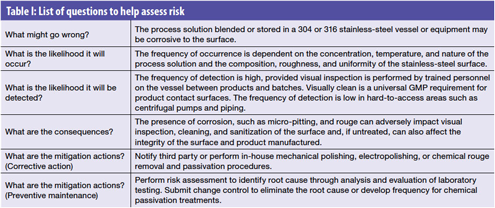Preventive and Corrective Maintenance for Rouge in Stainless-Steel Equipment
Equipment and Processing Report
Process conditions can corrode stainless-steel surfaces, necessitating corrective and preventive maintenance.
Stainless steel is usually the preferred substrate for good manufacturing practice (GMP) applications, and it constitutes the majority of GMP product-contact surface areas. The austenitic stainless-steel series (e.g., 304L and 316L) has been popular in pharmaceutical applications because of its high stain and corrosion resistance and affordability. Although stainless steel is named “stainless”, it is really “stain resistant”. This property comes from its ability to naturally form an oxide-rich, passive layer on the surface.
Passivation is a process in which a passive layer forms on the stainless-steel surface; this layer occurs naturally in the presence of oxygen when the surface has been cleaned of exogenous matter (1–3). The passive layer on the stainless-steel surface becomes the primary means of protection to prevent corrosion. Stainless steel can corrode, however, when the chromium-to-iron ratio has been significantly reduced, resulting in the oxidation and subsequent release of iron oxides that form deposits on surfaces.
Rouge is the commonly used term for the visible corrosion product of stainless steel; it can be composed of several forms of iron oxides, with ferric oxide being the predominant form (4–7). Rouging is typically found in water generation systems, process tanks, and pipeline systems that are routinely exposed to corrosive solutions. Rouge seems to be a common problem. Regulatory agencies such as FDA have cited in at least one warning letter that corrosion is unacceptable in direct-contact pharmaceutical systems (8). The reasoning is that rouge on product-contact surfaces can create an environment for process residues and microbes to tenaciously adhere to the rouged area and become more difficult to clean and sanitize (9-11). Residues and microbes might also reside within the rouge layers, where the routine cleaner and sanitizer may not be able to penetrate.
Preventive and corrective maintenance
Considering the risk associated with rouged surfaces, manufacturers would benefit from focusing more attention on treatments that prevent rouge from happening. Some companies take a reactive approach and wait until rouge has been detected or has impacted production before taking corrective action. Process attributes such as elevated temperature, extreme pH solutions, or surface damage (e.g., from poor quality welding) can corrode stainless-steel surfaces (4-7). If a process or surface condition is expected to lead to corrosion at some point during the life of the equipment, then an effort should be made to investigate and prevent that corrosion from occurring.
Unlike preventive maintenance, which is done to mitigate the cause of the potential problem or undesirable situation, corrective maintenance is done to correct a problem or fault once it has been detected. With a stainless-steel preventive maintenance procedure, for example, an operator knows exactly what needs to be done at a predefined schedule. On the contrary, in the case of a corrective maintenance, the critical parameters and overall procedure would depend on what is found. Corrective maintenance often requires evaluation of the severity of the rouge problem before any treatment can be recommended. This evaluation is referred to as a risk assessment, and includes a review of the potential impact to the patient, product, personnel, and equipment (12). Once the rouge is formed, there may be unknown variables associated with it and correcting the problem typically takes much longer than a preventive task. Many published references about stainless-steel corrosion are focused on corrective maintenance (3–11, 13–15).
When assessing the risk of the corrosion or rouge to the quality of the next product or batch, one should ask the questions about risk and mitigation actions summarized in Table I.
Table I. List of questions to help assess risk. Click to enlarge.

For more information
For more information about passivation treatments, laboratory tests to evaluate the effectiveness of passivation treatments, and tests to determine critical cleaning parameters for passivation, read the complete article by E. Rivera, P. Lopolito, and D. Hadziselimovic, "A Risk-Based Approach to Stainless Steel Equipment Maintenance," Pharmaceutical Technology 41 (2) 2017.
References
- ASTM International, A967–13,Standard Specification for Chemical Treatments for Stainless Steel Parts (West Conshohocken, PA, 2013).
- ASTM International, A380 / A380M-13, Standard Practice for Cleaning, Descaling, and Passivation of Stainless Steel Parts, Equipment, and Systems (West Conshohocken, PA, 2013).
- ASME, “Nonmandatory Appendix E: Passivation Procedure Qualification,” in Bioprocessing Equipment, BPE–2014 (New York, 2014).
- M.M. Gonzales, “Stainless Steel Tubing in the Biotechnology Industry, Biotechnology/Pharmaceutical Facilities Design,” (April 30, 2001) www.ispe.org/san-francisco/stainless-steel-tubing-biotechnology-industry.pdf.
- J.C. Tverberg and J.A. Ledden, “Rouging of Stainless Steel in WFI and High Purity Water Systems,” Proceedings of Tube 2000, (Dusseldorf, 2000).
- R.E. Avery and R.K. Raney, R. K. Eur. J. of Parenteral &Pharma. Services, 13 (1) 21-24 (2008).
- P. Lopolito, “Addressing Rouge in Biopharmaceutical Manufacturing Equipment,” Pharm.Tech. Equipment and Processing Report (Sept. 15, 2010) www.pharmtech.com/addressing-rouge-biopharmaceutical-manufacturing-systems.
- GMP Trends, “GMP Trends #886,” (Dec. 15, 2013).
- M. Gietl and P. Lopolito, “Rouge & Biofilm: Compounding Cleaning Challenges” (Sept. 18, 2014) www.pharmaceuticalonline.com/doc/rouge-biofilm-compounding-cleaning-challenges-0001.
- A. Deal, D. Klein, and P. Lopolito, “Strategies for biofilm remediation,” Cleanroom Technology (Jul. 31, 2015), www.cleanroomtechnology.com/technical/article_page/Strategies_for_biofilm_remediation/110760.
- A. Deal et al., “Use of the CDC Biofilm Reactor to Test Cleaning and Disinfection on Rouged Stainless Steel,” Reinraum Online, (March 20, 2015) www.reinraum.de/news_en.html?id=3179.
- International Conference on Harmonization (ICH) Q9 Quality Risk Management, November 2015.
- T. Blitz, et al. Pharm Eng. 35 (2) 60-69 (2015).
- T. Blitz, et al. Pharm Eng. 35 (3) 35-44 (2015).
- T. Blitz, et al. Pharm Eng. 35 (4) 81-91 (2015).
About the authors
Elizabeth Rivera is a technical services manager; Paul Lopolito is a senior technical services manager; and Dijana Hadziselimovic is a senior technical services associate, all at the Life Sciences Division of STERIS Corporation in Mentor, Ohio.
